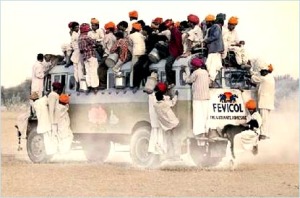Differentiation takes place in the mind of the consumer. But a mind has many limitations. It cannot bear over communication/information bombardment, confusion and conflicts. Mind looks out for simplicity, security and is highly resistant to change and can lose focus immediately. These factors are extremely important in the case of a rural consumer and hence the companies are spending a lot of time on doing in depth analysis of the rural mind set and the consumer buying behavior of the rural population.
Rural consumers tend to follow suit by buying what others buy. This is mainly attributed to the efforts to avoid perceived risk which involves
- Monetary risk: There is a chance I could lose money on this
- Functional risk: May be it would not work, nor do what it is supposed to do.
- Physical risk: It looks a little dangerous. I could get hurt
- Social risk: I wonder what my fellow villagers will think if I buy this
- Psychological risk: I might feel guilty or irresponsible if I buy this
All this explains why people tend to love underdogs but buy from the perceived leaders. Rural consumers also tend to be more loyal as brand switching has greater perceived risk.
The disturbing question that a marketer need to face in such a scenario is how to differentiate and position their product to grab the attention of the rural consumer who has an extremely insecure mind and highly resistant to change.
In such a scenario, differentiating factors can be ‘being first’ or ‘attribute ownership’. Getting into the mind a new idea or product or benefit is an enormous advantage. The bottom line is people tend to stick with what they have got. And if someone is the first, when the competitor tries to copy, all they do is reinforcing the idea of the leader. This has been the strategy of Fevicol, the company with one of the most successful ad campaigns.
Fevicol, the leader in the while glue segment had to fight their way through the ‘sticky’ market to emerge as the pioneers. When Fevicol came into business, the while glue was not famous among the carpenters. Initially, selling white glue was more like concept selling because the trade was used to glues based on natural products. Any concept selling like this is a difficult proposition and required patient working with the end users. For the first 5-7 years the challenge before the company was to make white glue the most preferred glue for making furniture. Thereafter, the journey has been guided by Pidilite’s desire to make the brand close to the customer. All the marketing activities for the brand, either at trade level or at carpenter level, or through the media, have been directed towards this objective.. Beginning with the Haisha campaign and graduating to the ‘huddle image’ of the Indian cricket team, humorous advertising has been playing a key role in building the Fevicol brand.
The big idea about how ‘some bonds are as unbreakable as the ‘Fevicol bond’ have paid dividends for Pidilite over the years in the rural market giving high brand recall for a low involvement product. The Indian rusticity is what stands out in all the Fevisol ads most of them being set in a rural backdrop involving carpenters, Melas, and Chaaywalas. Infact through their advertisements, the company made the name Fevicol generic to white glue though it is against the rules of differentiation. But discussing about the achievements, Fevicol succeeded through leadership and attribute ownership with the jingle ringing in everyone’s mind ‘Ye Fevicol ka jod hain; toottega nahin’. Here starts the success story of one Indian product differentiation.
